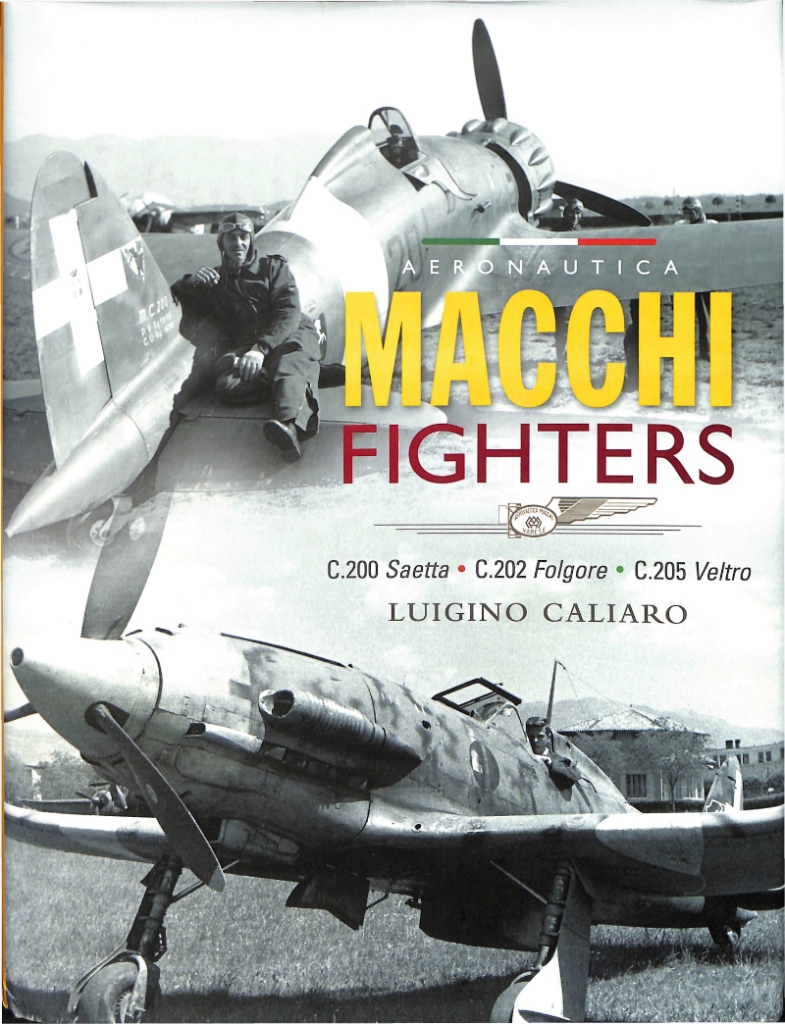Aeronautica Macchi Fighters: C.200 Saetta C.202 Folgore C.205 Veltro
Aeronautica Macchi Fighters: C.200 Saetta C.202 Folgore C.205 Veltro, Luigino Calairo, 2023, ISBN 978-1-80035-280-3, 288 pp.

When seeing the NASM’s Aeronautica Macchi C.202 Folgore fighter immediately thought what a beauty it is—though knowing little about Italy’s World War II designs since there is a dearth of English language publications about them. Author Luigino Caliaro is on a mission to fix that issue and filling in that somewhat empty niche. The first book in his planned trilogy of World War II Italian fighters is, Aeronautica Macchi Fighters: C.200 Saette C.202 Folgore C.205 Veltro has just published.
Caliaro’s Macchi Fighters exquisitely tells the tale of Aeronautical Macchi’s famed trio of World War II vintage fighters—the C.200 Saetta (Lightning); the C.202 Folgore (Lightning); and the C.205 Veltro (Greyhound). Caliaro goes much further by writing eloquently of Macchi’s history from the animal-drawn cart making firm during World War I to the present aerospace company of today. Each of these three World War II vintage aircraft type is described in fine detail technically, in drawings, as well as illustrations of details. The line drawings are breathtaking and details of everything from weapons, to gunsights to heraladic symbols are well produced.
Most of the immense number of photographs welcome a magnifying glass as they are well presented in this large format book. Additionally, the artwork of these fighters as they would have appeared in service is incredible.
These fighters, though few in numbers, were well traveled during World War II. With the surrender of Italy many Macchi fighters aircraft found themselves being flown for and fighting for Nazi Germany. Caliaro details units serving in Croatia and other countries—history hardly mentioned in English language books.
Caliaro also does not pull punches as he notes the poor decision making of Fascist Italy’s government of the time regarding production, designs, and especially forcing a power plant change from in-line engines to radial engines during the 1930s. Macchi, notably, had made great progress with its Schneider Cup hydroplane racing machines which all had in-line engines before that fateful decision. The government mandated switch to radial engines lessened the available power as Italian radials lagged behind in performance compared to other countries. Two more confusing decisions are also discussed which are weak armament and the lack of radio communication capability between aircraft. Somehow the Italian military decision makers, at the time, held to the theory which believed close-in aerobatic fighting was the future of air combat, never envisioning coordination between squadrons of fast moving, heavily armed rugged aircraft requiring more firepower as the gun runs became shorter in duration.
Macchi Fighters describes missions and events in brief though visceral passages. Italian fighter losses are likely accurate though their fighter victories may be less so since Italian combat report summaries were used as sources—but fighter pilots are known for overestimating success. Combat aircrew can be relied upon for less than accurate results given the speed of the aircraft and limited time for observation. This does not detract from the text, however, as these summaries reflect what the Italians perceived at the time and that is an aspect Caliaro excels at, perceiving reality from back in the day. What the designers contended with and what the pilots on the front lines experienced with these fighters.
Appendices cover aircraft on exhibit, in large as well as marvelous color images, and historic details. An index and bibliography also round this book out quite well. Macchi Fighters is a superbly produced book, as well.
Caliaro is an accomplished writer as well as photographer. His sincerity to objectively present the full history of these three fighter aircraft types is more than commendable. He has filled a niche with a book which belongs on any aviation history library’s shelves. His 2022 book on the Savoia-Marchetti SM.79 Sparviero sold out quickly and is not even on the used market, much less on library shelves. Caliaro’s books are that good.
It cannot be helped to question how the C.200 Saetta (Lightning); the C.202 Folgore (Lightning) have synonyms. Could this be? Well, yes and there is more. Thanks to native Italian Massimiliano Pinucci (designer and airship historian among many other professions) he advises that, yes, Saetta and Folgore both mean lighting in the Italian language. He goes on to mention the words have also moved on with time so folgore is no longer in use (with an important exception) and Italians have replaced the term with fulmine and lampo. Saetta has also morphed and now is used to infer exceptional speed. Importantly, Folgore remains the name of an elite historic paratroop division serving with the Italian armed forces.
Pinucci is also friends with Caliaro—it can be a small world.